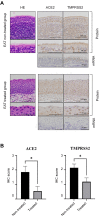Epipharyngeal Abrasive Therapy Down-regulates the Expression of SARS-CoV-2 Entry Factors ACE2 and TMPRSS2
- PMID: 34972736
- PMCID: PMC8765169
- DOI: 10.21873/invivo.12712
Epipharyngeal Abrasive Therapy Down-regulates the Expression of SARS-CoV-2 Entry Factors ACE2 and TMPRSS2
Abstract
Background: The epipharynx, with its high expression of Severe Acute Respiratory Syndrome Coronavirus 2 (SARS-CoV-2) entry factors angiotensin-converting enzyme 2 (ACE2) and transmembrane protease, serine 2 (TMPRSS2), is a primary target for SARS-CoV-2 replication in the early stage of Coronavirus Disease 19 (COVID-19). Epipharyngeal abrasive therapy (EAT) is a treatment for epipharyngitis in Japan which involves applying zinc chloride to the epipharyngeal mucosa. In this study, we evaluated the expression patterns of ACE2 and TMPRSS2 in tissue samples from patients before and after EAT.
Patients and methods: The study subjects were seven patients that had not been treated with EAT and 11 patients that had. For immunohistochemical assessment of the epipharyngeal mucosa, the staining intensity of ACE2 and TMPRSS2 was described as an immunohistochemical score (IHC score).
Results: The IHC scores for ACE2 and TEMPRSS2 in the EAT-treated group were 3.40-fold and 1.81-fold lower, respectively, than those in the non-treated group (p=0.0208 and p=0.0244, respectively).
Conclusion: EAT down-regulates the expression of SARS-CoV-2 entry factors ACE2 and TMPRSS2. Thus, EAT has potential as a novel COVID-19 preventative method.
Keywords: ACE2; EAT; Epipharyngeal abrasive therapy; SARS-CoV-2; TMPRSS2.
Copyright © 2022 International Institute of Anticancer Research (Dr. George J. Delinasios), All rights reserved.
Conflict of interest statement
The Authors declare that they have no competing interests.
Figures


Similar articles
-
Age and gender differences in ACE2 and TMPRSS2 expressions in oral epithelial cells.J Transl Med. 2021 Aug 19;19(1):358. doi: 10.1186/s12967-021-03037-4. J Transl Med. 2021. PMID: 34412632 Free PMC article.
-
Expression profiling meta-analysis of ACE2 and TMPRSS2, the putative anti-inflammatory receptor and priming protease of SARS-CoV-2 in human cells, and identification of putative modulators.Redox Biol. 2020 Sep;36:101615. doi: 10.1016/j.redox.2020.101615. Epub 2020 Jun 24. Redox Biol. 2020. PMID: 32863223 Free PMC article.
-
Nasopharyngeal Expression of Angiotensin-Converting Enzyme 2 and Transmembrane Serine Protease 2 in Children within SARS-CoV-2-Infected Family Clusters.Microbiol Spectr. 2021 Dec 22;9(3):e0078321. doi: 10.1128/Spectrum.00783-21. Epub 2021 Nov 3. Microbiol Spectr. 2021. PMID: 34730438 Free PMC article.
-
Polymorphisms and mutations of ACE2 and TMPRSS2 genes are associated with COVID-19: a systematic review.Eur J Med Res. 2022 Feb 22;27(1):26. doi: 10.1186/s40001-022-00647-6. Eur J Med Res. 2022. PMID: 35193695 Free PMC article.
-
ACE2 & TMPRSS2 Expressions in Head & Neck Tissues: A Systematic Review.Head Neck Pathol. 2021 Mar;15(1):225-235. doi: 10.1007/s12105-020-01212-5. Epub 2020 Aug 20. Head Neck Pathol. 2021. PMID: 32816230 Free PMC article.
Cited by
-
A Potential Novel Treatment for Chronic Cough in Long COVID Patients: Clearance of Epipharyngeal Residual SARS-CoV-2 Spike RNA by Epipharyngeal Abrasive Therapy.Cureus. 2023 Jan 5;15(1):e33421. doi: 10.7759/cureus.33421. eCollection 2023 Jan. Cureus. 2023. PMID: 36618501 Free PMC article.
-
Spatial transcriptomics of the epipharynx in long COVID identifies SARS-CoV-2 signalling pathways and the therapeutic potential of epipharyngeal abrasive therapy.Sci Rep. 2025 Mar 12;15(1):8618. doi: 10.1038/s41598-025-92908-7. Sci Rep. 2025. PMID: 40074801 Free PMC article.
-
Retracted: Chronic Epipharyngitis Treated with Epipharyngeal Abrasion Therapy: Symptoms, Diagnosis, Pathogenesis, and Treatment Outcomes.JMA J. 2025 Apr 28;8(2):371-384. doi: 10.31662/jmaj.2024-0437. Epub 2025 Mar 21. JMA J. 2025. PMID: 40416015 Free PMC article. Review.
-
Epipharyngeal Abrasive Therapy (EAT) Reduces the mRNA Expression of Major Proinflammatory Cytokine IL-6 in Chronic Epipharyngitis.Int J Mol Sci. 2022 Aug 16;23(16):9205. doi: 10.3390/ijms23169205. Int J Mol Sci. 2022. PMID: 36012469 Free PMC article.
-
The Interplay between Airway Cilia and Coronavirus Infection, Implications for Prevention and Control of Airway Viral Infections.Cells. 2024 Aug 14;13(16):1353. doi: 10.3390/cells13161353. Cells. 2024. PMID: 39195243 Free PMC article. Review.
References
-
- Sungnak W, Huang N, Bécavin C, Berg M, Queen R, Litvinukova M, Talavera-López C, Maatz H, Reichart D, Sampaziotis F, Worlock KB, Yoshida M, Barnes JL, HCA Lung Biological Network SARS-CoV-2 entry factors are highly expressed in nasal epithelial cells together with innate immune genes. Nat Med. 2020;26(5):681–687. doi: 10.1038/s41591-020-0868-6. - DOI - PMC - PubMed
-
- Hotta O, Inoue C, Tanaka A, Ieiri N. Possible mechanisms underlying epipharyngeal abrasive therapy (EAT) with ZNCl2 solution for the treatment of autoimmune diseases and functional somatic syndrome. J Antivir Antiretrovir. 2017;9(4):81–86. doi: 10.4172/1948-5964.1000168. - DOI
-
- Kaneko T, Mii A, Fukui M, Nagahama K, Shimizu A, Tsuruoka S. IgA nephropathy and psoriatic arthritis that improved with steroid pulse therapy and mizoribine in combination with treatment for chronic tonsillitis and epipharyngitis. Intern Med. 2015;54(9):1085–1090. doi: 10.2169/internalmedicine.54.3510. - DOI - PubMed
MeSH terms
Substances
LinkOut - more resources
Full Text Sources
Medical
Miscellaneous
